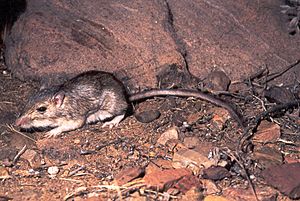Bailey's pocket mouse facts for kids
Quick facts for kids Bailey's pocket mouse |
|
|---|---|
 |
|
| Conservation status | |
| Scientific classification | |
| Genus: |
Chaetodipus
|
| Species: |
baileyi
|
Bailey's pocket mouse (Chaetodipus baileyi) is a small rodent. It is found in parts of Mexico and the United States. This mouse belongs to a group of rodents known for their special cheek pouches.
Contents
About Bailey's Pocket Mouse
Bailey's pocket mouse is a small mammal. When fully grown, it is about 17 to 24 centimeters (7 to 9.5 inches) long. Male mice are usually a bit bigger than females. Males weigh around 28 grams (1 ounce), while females weigh about 24.5 grams (0.8 ounces).
Who Discovered This Mouse?
A scientist named Clinton Hart Merriam first described Bailey's pocket mouse in 1894. He studied a mouse that Vernon Bailey had collected. This mouse was found in Magdalena, Mexico, in 1889.
Life in the Desert: Ecology
Bailey's pocket mouse lives in a burrow underground. It is a nocturnal animal, which means it is active at night. When it leaves its burrow to find food, it is very careful. It tries to stay hidden under plants or in shadows. This helps it avoid predators like owls. On bright, moonlit nights, it avoids crossing open areas.
What Do They Eat?
These pocket mice mainly eat seeds. They have special fur-lined pouches on the outside of their cheeks. They use these pouches to carry seeds back to their burrow. This keeps the seeds dry and safe.
Bailey's pocket mouse is very special. It is the only known animal that can digest the wax inside jojoba nuts. Most other mammals find jojoba seeds poisonous. This makes the mouse unique in the Sonoran Desert.
Filling a Gap in Nature
In the 1970s, scientists removed kangaroo rats from a desert area. For many years, no other small rodents moved into that space. But in 1995, Bailey's pocket mouse started to move in. It almost completely took the place of the missing kangaroo rats. This showed how adaptable these mice can be.
Conservation Status
The number of Bailey's pocket mice can change a lot. There might be between two and eighty mice per hectare. This depends on how much rain falls, which affects their food supply.
Scientists have not found any major threats to this species. Because of this, the International Union for Conservation of Nature has listed Bailey's pocket mouse as a species of "least concern". This means they are not currently at risk of disappearing.


